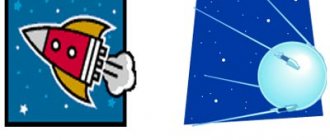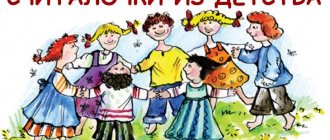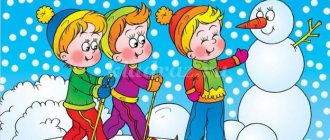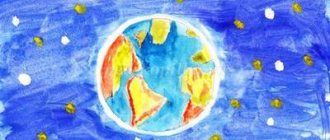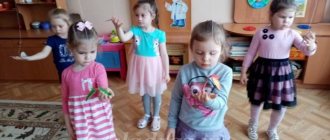Games in environmental education of preschool children
Currently, in pedagogical research much attention is paid to game forms of continuous environmental education. The content of games to get acquainted with the world around us is varied. They clearly reflect the interests of children and make their dreams and aspirations come true. This makes the game an important means of developing personality, cultivating moral feelings and motivations. The development of play creativity helps to develop in children the qualities necessary in life: focus, ingenuity, perseverance.
Play serves as a valuable means of personality formation. The game activates mental processes and arouses keen interest in understanding the world around us.
Through games, children overcome various difficulties, train their strength, develop their skills and abilities. Games help make any educational material fun and facilitate the process of learning. The role played has a positive effect on the awareness of preschoolers. Therefore, the game direction is actively used in the environmental education of preschoolers.
Three main approaches to gaming methods can be distinguished: the greening of traditional games, the adaptation of folk games and the creation of new games with ecological (or environmental) content.
It is also necessary to take into account the age characteristics of children, based on this, select appropriate games that ensure the development of the personality of each child, the development of environmental consciousness, and contribute to in-depth knowledge of living and inanimate nature. Different materials are used for games (natural material, printed board games (lotto, cut-out pictures)).
It must be remembered that not every game can be environmental in its goals and content. Therefore, in order to realize the objectives of environmental education through games, careful pedagogical selection and analysis of game material is necessary.
When choosing games for environmental education of preschoolers, you must comply with the following requirements:
— games are selected taking into account the patterns of children’s development and the objectives of environmental education;
— the game should enable the child to apply acquired environmental knowledge in practice and stimulate him to learn new ones;
— the content of the game must correspond to environmental knowledge;
— game actions are carried out in accordance with the rules and norms of behavior in nature;
— each new game must correspond to the objectives of environmental education and have a connection with the previous and subsequent games.
When conducting games with the aim of enriching, expanding and deepening environmental ideas, one should take into account those ideas that can be formed in older preschoolers:
- about man as a part of nature;
— about the diversity and diversity of natural objects, about animals and plants as living organisms;
— about the culture of behavior in nature;
— about relationships and interdependencies in nature (between living and inanimate nature, as well as between objects of living nature).
To enrich environmental ideas, it is advisable to carry out games with a small subgroup of children; use games in variants, depending on the level of development of preschoolers’ ecological ideas.
The content of the game should be aimed at developing an emotional and value-based attitude towards nature in older preschoolers. Usually these are games for the development of aesthetic perception of nature (emotional attitude towards nature, a sense of beauty in it) and games for the formation of moral and evaluative experience of the behavior of preschoolers in nature.
In the first case, preschoolers, when in direct contact with natural objects (touching an animal, plant, stroking a flower, leaves, etc.), tell something interesting about the natural object, for example, a description of the appearance, characteristics of growth, care, caring attitude to animals and plants. Such games are best played in natural conditions, on a playground, for example.
In addition, in the process of observing and studying natural phenomena, an emotional impulse is born in children, indifference and indifference are completely eliminated, creative thinking and the desire to learn more new things increase. The child becomes attentive to the natural world and everything that happens in it. He takes the position of protector and creator of beauty in nature. This is how emotional responsiveness is formed, the excitement of meeting the unknown in nature, the joy of upcoming knowledge, anticipation of unusual and wonderful encounters in this world, one’s strengths and abilities regarding the study of the surrounding nature.
The basis of games for the formation of moral and evaluative experience of behavior in nature are certain situations. So, during the games, the consequences of bad and good actions of adults and children are discussed, their own solutions are searched for in difficult situations, children learn to motivate their decisions. The main feature of games for a moral and evaluative attitude towards nature is that games do not give children ready-made solutions; the child must independently draw conclusions.
In pedagogical science, games are classified into several groups. F. Frebel, one of the first among teachers who put forward the position of play as a special means of education. The researcher based his classification on the principle of the differentiated influence of games on the development of the mind (that is, mental games), movements (motor games) and external senses (sensory games).
N.K. Krupskaya children's games are divided into
- games invented by the children themselves. These games are independent in nature.
- games invented by adults, these games are played according to certain rules.
Let's look at the types of games.
Role-playing game is a reproduction of events that occur in everyday life.
The main condition for role-playing play is that children have certain knowledge about this or that side of reality, as well as about the activities of people in it, their specific situational behavior.
Considering that the problem of games is considered relevant in preschool pedagogy, scientists are putting forward a new classification of children's games (S.L. Novoselova). The classification is based on the idea of whose initiative games arise (an adult or a child).
There are three classes of games:
1. Games that arise on the initiative of children: director's games, role-playing games, theatrical games, plot-display games.
2. Games initiated by an adult
— educational games: intellectual, active, plot-didactic, theatrical and staged;
- leisure games: entertainment games, fun games, festive carnival games, intellectual games.
H. Folk games that can arise on the initiative of both an adult and older children: folk and traditional.
There are also creative games. These are games in which the child shows intelligence and creativity.
Creative games include games in which the child shows his creativity, initiative, and independence. The creative manifestations of children in games are varied: from inventing the plot and content of the game, searching for ways to implement the plan, to impersonating the roles given by the literary work. Depending on the nature of children’s creativity and the playing material used in games, creative games are divided into director’s games, role-playing games, theatrical games, and games with building materials.
Role-playing games in the process of educating ecological culture presuppose the presence of environmental, natural history or ecological content and the existence of certain rules. When drawing up a work plan within the framework of the program, the teacher should develop a number of games that help children get acquainted with various natural phenomena or processes. For example, during the game “Journey of a Droplet,” preschoolers become droplets of water. Mother Tuchka lets these droplets go for a walk on the ground to help people, animals and plants. On earth, droplets first merge into streams, then into rivers, and then into the ocean. Then, along the way, the droplets water the plants, or water the animals, etc. and return to Mother Tuchka to tell her about what they saw and what they did. Thus, children aged 5-6 years old get their first ideas about the water cycle in nature in a playful way.
Another game is “Trees and Worms,” which is designed specifically for children’s first acquaintance with the processes of soil formation. The guys are divided into two teams. Each team has its own “tree”, which, as a rule, sheds its leaves in the fall, as well as its own “earthworm” with cups of earth. Then, during the game, according to the rules, the children “exchange” the fallen leaves of the tree with the soil that the “earthworm” gives away. This reinforces preschoolers’ understanding of soil formation and the role of living organisms (earthworms) in this process.
When greening traditional role-playing games, the principles of accessibility of content selection and scientific character should be observed.
It should be noted that today there are a huge number of didactic games with environmental content. Many of them were developed by teachers themselves. Among the games, we can also highlight object games that involve the use of natural materials: pebbles, cone shells, sand, etc. It has long been known that natural materials contribute to the development of a child’s thinking. For example, natural objects can be classified according to different characteristics (shape, color, size, nature of origin). It is very important that children also participate in collecting natural materials.
It is effective to use intellectual games in pedagogical practice. As research shows, such well-known games as “What? Where? When?”, “KVN”, “Brain-ring”, quizzes that can be successfully used for the purposes of environmental education for older preschoolers, but subject to their adaptation to the preschool level
(in some cases, such games turn not into creative competitions, but into children’s mechanical reproduction of various pre-prepared texts).
Another type of game is independent play, which has recently also been used by teachers. In addition, today, due to the spread of video technology, computers and television, children have forgotten how to play independently. In general, environmental content is rarely included in independent content. This is due to the emphasis of adults on school-type activities, that is, preparation for school. In some preschool institutions, they organize a celebration of initiation into “young ecologists”, and conduct it in the form of a school exam: the child must choose a ticket on the table with questions and answer it to the examination committee. Creating conditions for independent play requires special attention from the teacher.
Another important type of environmental game is travel games. As a rule, travel here serves the function of excursions. Children visit exhibitions, a zoo, an animal farm, and museums. In the process of playing and traveling, children also visit new, interesting places and expand their existing knowledge, gaining new knowledge about nature. The teacher in this game plays the main role - farm manager, tour guide, etc.
Thus, we came to the conclusion that the game helps to form environmental knowledge, cultivate environmental culture, which is the formation of the personality of a preschooler.
Conclusion:
In the environmental education of preschoolers, it is necessary to change the old, traditional anthropocentric paradigm to a new ecocentric one, which makes it necessary to abandon a number of stereotypes formed in previous years. Nature should not be viewed only from a utilitarian point of view. First of all, it is necessary to show children its uniqueness, beauty and universality: nature is the living environment of all creatures, including humans, an object of knowledge, satisfying its aesthetic needs; and only then – an object of human consumption.
Instilling in children a love for nature and the ability to perceive its beauty is one of the important tasks of a child care institution. The task of adults is to show children the uniqueness of nature, its beauty and universality: nature is the living environment of all creatures, including humans, an object of knowledge, the satisfaction of its aesthetic needs; and only lastly is it an object of human consumption.
The problem of games is considered relevant in preschool pedagogy. The classification is based on the idea of on whose initiative the games arise (an adult or a child):
1. Games that arise on the initiative of children: director's games, role-playing games, theatrical games, plot-display games.
2. Games initiated by an adult:
— educational games: intellectual, active, plot-didactic, theatrical and staged;
- leisure games: entertainment games, fun games, festive carnival games, intellectual games.
H. Folk games that can arise on the initiative of both an adult and older children: folk and traditional.
MAGAZINE Preschooler.RF
DIDACTIC GAMES WITH NATURAL SCIENCE CONTENT AS A MEANS OF ECOLOGICAL DEVELOPMENT OF SENIOR PRESCHOOL CHILDREN.Self-development of a teacher - steps to successful professional activity.
How can we teach children to take care and protect nature, all living things around us? V.A. Sukhomlinsky considered it necessary to introduce a child to the natural world around him so that every day he discovers something new for himself in it, grows up as a researcher, so that every step he takes is a journey to the origins of miracles in nature, ennobles his heart. It is in childhood that a child receives emotional impressions of nature and accumulates ideas about different forms of life. Adults raising a child at this moment must show the little person the wonderful world of nature, help establish relationships with him, only then will the child develop the fundamental principles of ecological thinking, consciousness, and the initial elements of ecological culture. The relevance and importance of the problem under consideration determined the choice of topic: “Didactic games of natural history content as a means of ecological development of children of senior preschool age.” Since play is the main type of activity in kindergarten, I have compiled a card index of didactic games aimed at developing in preschoolers a consciously correct attitude towards nature.
Children happily respond to an invitation to play, anticipating the joy of entertainment and not realizing that they will actually learn. The children used the knowledge gained during play activities in didactic games: “Find a pair”, “Find a plant with large (small) leaves”, “Find out by description”, “Let’s show the bear our corner of nature.” Increasingly, the role of presenter was already entrusted to the children, and the rules of the game were explained before it began. The following didactic games helped to develop the ability to analyze, compare, classify, and consolidate the knowledge necessary for the subsequent formation of such concepts as “environment”, “nature conservation”: “Who eats what? ", "Who lives where? ”, “Flies, does not fly”, “Animals, birds, fish”, “Whose children? ”, “Tops, roots”, “Children on a branch” and others. At an older age, one of the options for combining didactic and gaming tasks in an activity appears, which is a plot-didactic game: “Journey to Africa”, “Journey to the sea (to the Far North)”. In the process of plot-based didactic games, where there is a plot and roles, children mastered new knowledge in the game. Through these games, children develop a consciously correct attitude towards plants and animals, towards themselves as part of nature. Outdoor games of a natural history nature “Geese-geese”, “Cat and mice”, “Wolf and hares”, “Foxes in the chicken coop”, “Birds in nests”, “Sparrows and cat”, which are associated with imitation of the habits of animals, their way of life. By imitating actions, imitating sounds, children consolidated their accumulated knowledge; The joy gained during the game contributed to a deepening interest in nature. Thus, in the older group, when playing environmental games, children’s ideas about the world around them are consolidated and systematized. Taking this into account, work was carried out to develop in older preschoolers the ability to analyze an object or phenomenon, compare, generalize according to selected features, establish connections between facts, and develop the ability to give an appropriate assessment of the possible consequences of their actions (rules of behavior in nature). In older children, games already have more complex content, so the connection of didactic games with other types of children's activities, with creative games, artistic activities, and labor was thought out. In creative games, children learned to depict natural objects. During the game, the child remembered the properties, features of this natural object (plant, animal, inanimate object), its relationship with other natural objects. These are the following games: “I am a tree”, “I am a caterpillar”, “I am a frog”, “I am a droplet” (water). By planning didactic games related to artistic activities, children’s ability to analyze the world around them was formed and, consequently, their thinking developed. So, in artistic activities, when children were drawing birds on the topic: “Draw what kind of bird you want,” I used the game “Find by description,” during which the children consolidated the characteristic features of birds. In artistic activities, you can also play the following games: “Who is more observant? ", "Guess what kind of plant (animal) it is? ”
Thus, as a result of the work done on environmental education, children began to perceive with interest the objects and phenomena of the natural world, as well as respond to “disorders” in their use, and make value judgments about them; there was a desire to comply with norms and rules of behavior in the environment aimed at preserving the values of the natural world.
LITERATURE
- Artemova L.V. The world around us in didactic games for preschoolers: a book for kindergarten teachers and parents / L.V. Artemova. -M.: Education, 1992. -96 p.
- Bondarenko A.K. Didactic games in kindergarten/A. K. Bondarenko. -M.: Education, 1985. -176 p.
- Dryazgunova V.A. Didactic games for introducing preschoolers to plants: a manual for kindergarten teachers. /IN. A. Dryazgunova. -M.: Education, 1981. -80 p.
- Voronkevich O.A. Welcome to ecology. Partial program of work on the formation of environmental culture in preschool children. -SPb.: ”Childhood-press”, 2021. -512 p.
| Next > |
